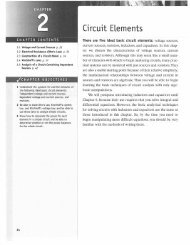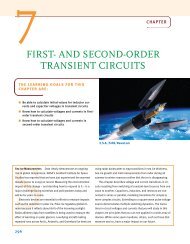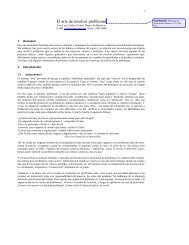Create successful ePaper yourself
Turn your PDF publications into a flip-book with our unique Google optimized e-Paper software.
8 CHAPTER 1 <strong>BASIC</strong> <strong>CONCEPTS</strong><br />
Learning Assessment<br />
E1.2 Determine the unknown variables in Fig. E1.2.<br />
I=2 A<br />
ANSWER:<br />
(a) V 1 =-20 V;<br />
(b) I =-5 A.<br />
– P=40 W<br />
V 1 =?<br />
+<br />
+ P=–50 W<br />
V 1 =10 V<br />
–<br />
+<br />
10 V<br />
–<br />
I=?<br />
Figure E1.2<br />
(a)<br />
(b)<br />
Finally, it is important to note that our electrical networks satisfy the principle of conservation<br />
of energy. Because of the relationship between energy and power, it can be implied<br />
that power is also conserved in an electrical network. This result was formally stated in 1952<br />
by B. D. H. Tellegen and is known as Tellegen’s theorem—the sum of the powers absorbed<br />
by all elements in an electrical network is zero. Another statement of this theorem is that the<br />
power supplied in a network is exactly equal to the power absorbed. Checking to verify that<br />
Tellegen’s theorem is satisfied for a particular network is one way to check our calculations<br />
when analyzing electrical networks.<br />
1.3<br />
Circuit Elements<br />
Thus far we have defined voltage, current, and power. In the remainder of this chapter we will<br />
define both independent and dependent current and voltage sources. Although we will<br />
assume ideal elements, we will try to indicate the shortcomings of these assumptions as we<br />
proceed with the discussion.<br />
In general, the elements we will define are terminal devices that are completely characterized<br />
by the current through the element and/or the voltage across it. These elements, which<br />
we will employ in constructing electric circuits, will be broadly classified as being either<br />
active or passive. The distinction between these two classifications depends essentially on<br />
one thing—whether they supply or absorb energy. As the words themselves imply, an active<br />
element is capable of generating energy and a passive element cannot generate energy.<br />
However, later we will show that some passive elements are capable of storing energy.<br />
Typical active elements are batteries and generators. The three common passive elements are<br />
resistors, capacitors, and inductors.<br />
In Chapter 2 we will launch an examination of passive elements by discussing the resistor<br />
in detail. Before proceeding with that element, we first present some very important active<br />
elements.<br />
1. Independent voltage source 3. Two dependent voltage sources<br />
2. Independent current source 4. Two dependent current sources<br />
INDEPENDENT SOURCES An independent voltage source is a two-terminal element<br />
that maintains a specified voltage between its terminals regardless of the current through it<br />
as shown by the v-i plot in Fig. 1.14a. The general symbol for an independent source, a circle,<br />
is also shown in Fig. 1.14a. As the figure indicates, terminal A is v(t) volts positive with<br />
respect to terminal B.<br />
In contrast to the independent voltage source, the independent current source is a twoterminal<br />
element that maintains a specified current regardless of the voltage across its<br />
terminals, as illustrated by the v-i plot in Fig. 1.14b. The general symbol for an independent<br />
current source is also shown in Fig. 1.14b, where i(t) is the specified current and the arrow<br />
indicates the positive direction of current flow.













